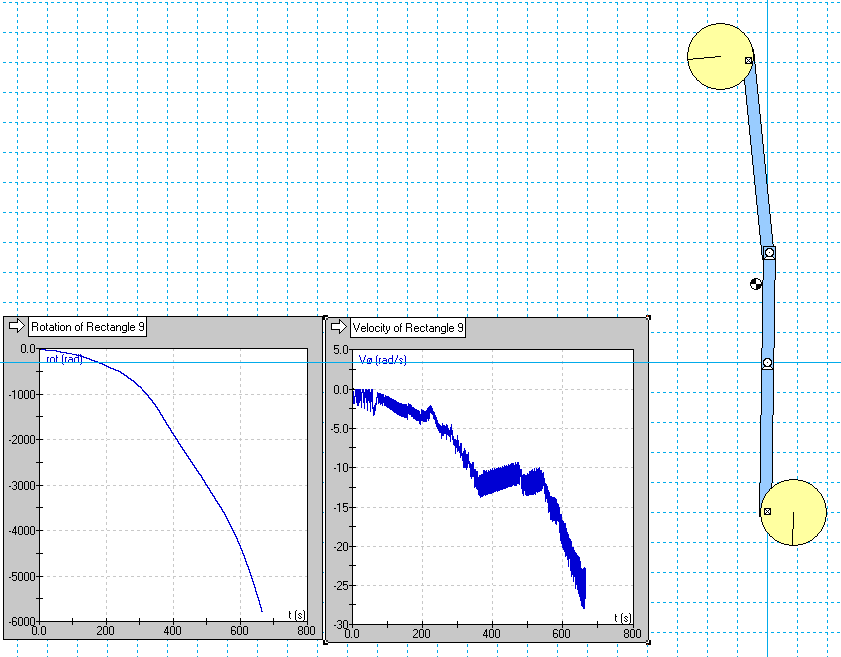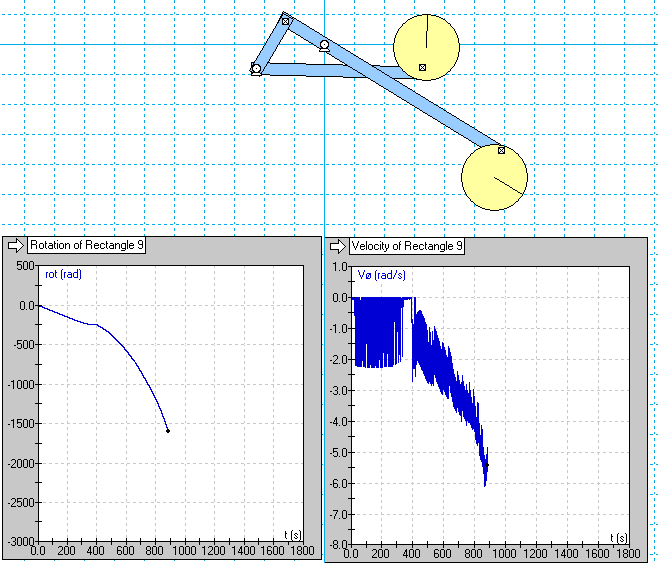Jhula - a system for clean energy
By Prajna Pranab, 23 March 2007
What if I was to describe a system to you that could increase its energy not by putting more energy into the system but by judiciously removing energy from it?
That would require some 'thinking outside the box', would it not?
The system I describe is called 'Jhula', a Sanskrit word meaning 'swing'.
Jhula is a very simple machine consisting of a counterweight and a pendulum. The counterweight is connected via a bearing to some fixed point and the bearing is positioned in an eccentric manner (what else would you expect from someone who is eccentric?)
The pendulum is connected to the end of the counterweight by another bearing, which is able to be locked by means of a brake.
Here is a model of how it might look:

And an animation of the Jhula operating merely under the influence of gravity:
Jhula - animation (58Mb .gif)or
Jhula - animation (5.8Mb .avi)
or
Jhula - model (7Kb .wm2d)
If you are astute you will notice that there are periods during the seemingly chaotic swinging of the pendulum and counterweight where simply locking the bearing that connects the pendulum to the counterweight will cause the unbalance of the system to add momentum to the counterweight.

Point 'A'
At point 'A', above, you can see that the pendulum is about to swing down clockwise because it is free to rotate about its bearing. If, by latching the bearing, we could fix the relationship between the pendulum and the counterweight then, because the system centre of mass is off to the right, the system would accelerate clockwise. Once the pendulum has passed the bottom of the cycle we could release the latch and let the system take care of itself until latching would again add momentum.
If you imagine the pendulum as a swing then I am sure you can get a feel for when you would latch the bearing and when you would release it. Indeed, I propose that it would be useful to build a swing based on this design in order to demonstrate the principle. A disc brake could be used to latch the pendulum bearing. I believe it would be quite a ride! As Buzz Lightyear might say "It might not be flying but it certainly is falling with style".
Notice that the only energy input into the system, apart from that required to start it, is the small effort needed to latch the bearing. The thing that increases the energy output is intelligence rather than effort; the intelligence to know when to apply the brakes and when to release them.
Sensing when to operate the latch may, at first glance, seem to be quite a significant problem but careful observation of the animation will reveal that there are a few simple rules that will operate to increase the system momentum in a clockwise direction. When the pendulum is to the right of the counterweight axle and the angle between the pendulum and the counterweight is not changing then is an advantageous moment to engage the latch. Once the pendulum has passed the bottom point the latch should be released. There are likely to be other optimisations that can be added but even with these two simple rules it should be possible to extract energy from the system.
I used Working Model 2D to model this machine. Still to be done is to model the intelligent latching, something that is beyond the capabilities of WM2D, and to analyse the output. I would also like to build a Jhula device that can be used as a swing, complete with disc braking on the pendulum hub. I think that it would make a great fairground ride for demonstration and promotion of the idea and it could be connected to a generator to produce clean 'human powered' energy, produced more enjoyably and with less effort than pedalling the Rinky Dink Sound System. Eventually, of course, I would like to develop a generating system with built in logic, powered simply by gravity; won't that be something to look forward to?
So there you are, the Jhula device. Time for the builders to get in their workshops to see how they can realise the principle.
This concept is offered free for experiment and development on the basis that nothing derived from it may be patented or trademarked.
You may contact me via the forums on overunity.com
Prajna
30 March 2007
I'm rushing to get this published before April the 1st since many people will be convinced that it must be a joke.
Jhula just gets more interesting... When I first looked at the concept it seemed that it was going to take quite some logic to get Jhula to run and possibly even (dare we imagine it) run at over unity, accelerating due to gravity. My first effort was to add a ratchet to limit the swing of the pendulum so that it would only swing in one direction. I designed a mechanical ratchet to achieve that and it showed promise but WM2D was having problems modeling it (WM2D isn't great at handling complex polygons).
Then xnonix from the overunity forum leapt to my aid and showed me how to simulate a ratchet using a motor. He went further and added a similar latch to the main axle bearing and then we had a most interesting machine.

Jhula - xnonix mod (7Kb .wm2d)
That particular model seems fairly stable compared to others I have created, some of which seem to produce overunity in spades.
That is an extraordinary claim, I know. Before you write this off as lunacy, though, take a look at the following model. Even better, grab a pair of rear axles (freewheels) from a couple of bicycles and build a real version based on this model. Make sure you include a braking system because this thing can accelerate to destruction. The negative values on the graphs are because the device is rotating clockwise but they clearly indicate the acceleration.

Jhula Minum model (7Kb .wm2d)
Also interesting is this following version. You can see that there are a number of configurations
that can be used. Each has their own characteristics. Some sit there just ticking over,
some seem completely chaotic and some accelerate reasonably smoothly.

Jhula Minum Crank model (7Kb .wm2d)
I am sure that this machine is going to give physicists a few headaches but it is remarkably simple to build and test for yourself. If you do so, or if you are a physicist who has a good explaination of what is happening in this system, please post a message in this thread on overunity.com.
Prajna